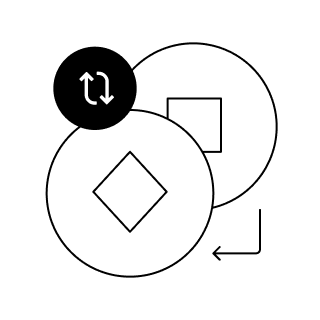How to buy Polkadot (DOT) in 3 steps
Whether you’re new to crypto or an experienced trader, you can buy crypto using the OKX Exchange.
Step one
Get OKX
If you haven’t already, download the OKX app and sign up to get started.
Step two
Fund your account
Make a deposit using your preferred payment method.
Step three
Choose your crypto
Select the crypto you’d like to buy from the 270+ available on OKX.
What’s Polkadot (DOT)? How can I buy it?
<h2>What is Polkadot?</h2>
<p>Polkadot is a next-generation, open-source blockchain protocol designed to enable interoperability, scalability, and shared security across multiple specialized blockchains. Conceived by Dr. Gavin Wood (co-founder and former CTO of Ethereum) and developed by Web3 Foundation and Parity Technologies, Polkadot aims to power a decentralized web (Web3) where independent blockchains can exchange information and value trustlessly.</p>
<p>At its core, Polkadot is a Layer-0 meta-protocol: it provides the foundational infrastructure on which many Layer-1 blockchains (called parachains) can run in parallel and communicate. The protocol’s native token, DOT, is used for network governance, staking to secure the network, and bonding to connect new parachains.</p>
<p>Key goals:</p>
<ul>
<li>Interoperability: Seamless cross-chain messaging and asset transfers.</li>
<li>Scalability: Parallel transaction processing across many chains.</li>
<li>Shared security: Parachains inherit the security of the Polkadot relay chain.</li>
<li>Upgradeability: Forkless, on-chain upgrades governed by token holders.</li>
</ul>
<p>Notable ecosystem components include the Relay Chain (the network’s security and coordination layer), parachains (sovereign blockchains optimized for specific use cases), cross-consensus messaging (XCM) for cross-chain communication, and bridges that connect to external networks like Ethereum or Bitcoin.</p>
<p>Sources: Polkadot Whitepaper and documentation (polkadot.network, docs.polkadot.network); Web3 Foundation; Parity Technologies.</p>
<h2>How does Polkadot work? The tech that powers it</h2>
<p>Polkadot’s architecture is modular and multi-chain, designed to address the trilemma of security, scalability, and decentralization.</p>
<ul>
<li>
<p>Relay Chain:</p>
<ul>
<li>The central chain responsible for shared security, consensus, and cross-chain interoperability.</li>
<li>Keeps transaction logic minimal to maximize throughput and security.</li>
<li>Manages parachain slot allocation and finality.</li>
</ul>
</li>
<li>
<p>Parachains:</p>
<ul>
<li>Independent, application-specific blockchains that connect to the Relay Chain for security and interoperability.</li>
<li>Built with Substrate (a modular blockchain SDK by Parity), parachains can optimize for DeFi, identity, gaming, privacy, or enterprise use cases.</li>
<li>Execute transactions in parallel, significantly increasing network throughput.</li>
</ul>
</li>
<li>
<p>Parathreads:</p>
<ul>
<li>“Pay-as-you-go” parachains that share slots on a block-by-block basis—ideal for projects not requiring continuous block production.</li>
</ul>
</li>
<li>
<p>Cross-Consensus Messaging (XCM):</p>
<ul>
<li>A format and set of protocols enabling secure, programmable communication across parachains and other consensus systems.</li>
<li>Supports asset transfers, remote contract calls, governance messages, and more without centralized bridges.</li>
</ul>
</li>
<li>
<p>Bridges:</p>
<ul>
<li>Specialized parachains or external components that connect Polkadot to other ecosystems (e.g., Ethereum).</li>
<li>Enable asset and data portability beyond Polkadot’s native environment.</li>
</ul>
</li>
<li>
<p>Consensus and Security:</p>
<ul>
<li>Nominated Proof-of-Stake (NPoS): DOT holders nominate validators who secure the network; nominators share in rewards and risks (slashing).</li>
<li>BABE (Blind Assignment for Blockchain Extension): Block production mechanism selecting validators to author blocks in time slots.</li>
<li>GRANDPA (GHOST-based Recursive ANcestor Deriving Prefix Agreement): Finality gadget that finalizes blocks rapidly across long chains of blocks.</li>
<li>Shared security model: Parachains rely on the Relay Chain’s validator set, avoiding the need to bootstrap their own security.</li>
</ul>
</li>
<li>
<p>Governance and Upgradeability:</p>
<ul>
<li>On-chain governance allows DOT holders and elected bodies (e.g., Technical Committee in earlier versions, now OpenGov with multiple tracks) to propose and vote on changes.</li>
<li>Forkless upgrades via runtime changes; avoids disruptive hard forks and enables rapid iteration.</li>
</ul>
</li>
<li>
<p>Development Stack:</p>
<ul>
<li>Substrate: A Rust-based framework with prebuilt pallets (modules) for accounts, balances, governance, smart contracts (ink!), and more.</li>
<li>The flexibility of Substrate lets teams tailor economic models, consensus parameters (when used as standalone chains), and runtime logic while still plugging into Polkadot’s shared security when deployed as parachains.</li>
</ul>
</li>
</ul>
<p>This interplay of parallel execution, shared security, and robust cross-chain messaging differentiates Polkadot’s approach from monolithic L1s and many rollup-centric designs.</p>
<h2>What makes Polkadot unique?</h2>
<ul>
<li>Layer-0 meta-protocol: Instead of being just another smart contract chain, Polkadot is the foundation for many sovereign chains that can evolve independently yet remain interoperable.</li>
<li>True interoperability via XCM: Beyond token transfers, Polkadot supports rich, programmable cross-chain interactions without relying on centralized custodial bridges.</li>
<li>Shared security with parallelism: Parachains inherit strong security from a common validator set while executing transactions in parallel, enabling scale without fragmenting trust.</li>
<li>Forkless evolution: Runtime upgrades occur on-chain, allowing the protocol and parachains to evolve quickly and safely.</li>
<li>Developer ergonomics with Substrate: Teams can ship application-specific blockchains faster, with pallets handling common concerns. This lowers the barrier to innovation.</li>
<li>Governance via OpenGov: Granular, track-based governance enables faster, more inclusive decision-making, aligning protocol changes with community priorities.</li>
</ul>
<h2>Polkadot price history and value: A comprehensive overview</h2>
<p>Note: Cryptocurrency markets are highly volatile. Always verify current data with reputable sources such as CoinDesk, CoinMarketCap, or Messari.</p>
<ul>
<li>
<p>Launch and early trading:</p>
<ul>
<li>DOT underwent a redenomination in August 2020 (100:1), which adjusted the token’s unit count and price per token without changing total value.</li>
<li>Following its listing on major exchanges, DOT quickly became a top-10 market cap asset during the 2020–2021 bull cycle.</li>
</ul>
</li>
<li>
<p>Bull market peak:</p>
<ul>
<li>In late 2021, DOT reached an all-time high amid broader crypto market exuberance and anticipation of parachain slot auctions.</li>
</ul>
</li>
<li>
<p>Bear market drawdown:</p>
<ul>
<li>Through 2022–2023, macro tightening, crypto-specific risk events, and risk-off sentiment led to a substantial retracement from all-time highs.</li>
</ul>
</li>
<li>
<p>Ecosystem and fundamentals:</p>
<ul>
<li>Parachain auctions (now transitioning as leasing evolves) onboarded diverse projects (DeFi, identity, gaming, RWA).</li>
<li>Continued technical upgrades (XCM enhancements, OpenGov rollout, performance improvements) underpin long-term value propositions.</li>
</ul>
</li>
<li>
<p>Value drivers and risks:</p>
<ul>
<li>Drivers: Adoption of parachains and dApps, cross-chain use cases, developer growth, governance agility, and bridging to external ecosystems.</li>
<li>Risks: Competition from other modular stacks, L2 ecosystems, and alternative interoperable protocols; regulatory uncertainty; execution risk in scaling user adoption.</li>
</ul>
</li>
</ul>
<h2>Is now a good time to invest in Polkadot?</h2>
<p>This is not financial advice. Consider these factors and conduct your own research:</p>
<ul>
<li>
<p>Thesis alignment:</p>
<ul>
<li>If you believe the future of blockchain is multi-chain and interoperable—with app-specific chains communicating natively—Polkadot directly targets that future.</li>
<li>The shared security plus app-chain model competes with modular L2 rollups on Ethereum; assess which architecture you expect to dominate.</li>
</ul>
</li>
<li>
<p>Fundamentals to monitor:</p>
<ul>
<li>Active users and TVL across major parachains.</li>
<li>XCM usage metrics (cross-chain messages/volume).</li>
<li>Developer activity: GitHub commits, new Substrate-based projects, grants.</li>
<li>Governance cadence and outcomes (e.g., network upgrades, fee economics).</li>
<li>Bridge maturity and integrations with external chains.</li>
</ul>
</li>
<li>
<p>Token economics:</p>
<ul>
<li>DOT utility includes staking yields, governance rights, and parachain bonding economics (subject to evolving models).</li>
<li>Evaluate staking participation, inflation vs. burn dynamics (e.g., fees), and slashing risk.</li>
</ul>
</li>
<li>
<p>Market conditions:</p>
<ul>
<li>Macro factors (rates, liquidity), crypto market cycles, and regulatory developments can overshadow fundamentals in the short term.</li>
<li>Dollar-cost averaging and position sizing can mitigate timing risk in volatile markets.</li>
</ul>
</li>
<li>
<p>Competitive landscape:</p>
<ul>
<li>Compare performance, fees, UX, and security assumptions against Ethereum L2s, Cosmos app-chains (IBC), Avalanche subnets, and other interoperable frameworks.</li>
</ul>
</li>
</ul>
<p>Bottom line: Polkadot presents a robust, technically distinctive approach to scaling and interoperability. For investors with a long-term, multi-chain conviction and tolerance for crypto’s volatility and execution risk, DOT may merit consideration after thorough due diligence.</p>
<p>References and further reading:</p>
<ul>
<li>Polkadot Lightpaper and Wiki: polkadot.network, wiki.polkadot.network, docs.polkadot.network</li>
<li>Web3 Foundation and Parity Technologies research and blogs</li>
<li>Independent analytics: Messari, Coin Metrics, Electric Capital Developer Report</li>
<li>Market data: CoinGecko, CoinMarketCap, CoinDesk</li>
</ul>
Discover the different ways to buy crypto
Here are a few step-by-step beginner’s guides to help you make your first purchase.
1
Create an OKX account
Download the OKX mobile app and sign up using your email address or phone number.
2
Get verified
Complete identity verification to secure your account. You’ll just have to provide your ID, a selfie, and some personal information.
3
Start a trade
Tap the Buy button on the homepage. Use the dropdown to select DOT.
4
Enter an amount
Enter the amount of Polkadot you’d like to purchase in your local fiat currency.
5
Choose your payment method
Tap on Payment method and select Card. Tap on Preview to view your purchase details. Then, tap the Buy button to complete your purchase.
6
Confirm your order
If prompted, confirm your purchase on your bank’s associated mobile banking app.
7
All done
We’ll notify you once your purchase is complete. That’s it. You own crypto.
1
Get the OKX app or Wallet extension
Download the OKX mobile app on your mobile device or install the OKX Wallet extension.
2
Set up your wallet
Go to the menu and find Web3 Wallet. Follow the instructions to create or import a wallet. Make sure to back up your seed phrase.
3
Fund your wallet
Deposit your crypto into your OKX Wallet to cover your crypto purchase and network fees. You can make a direct deposit through the Exchange or receive the tokens from another wallet.
4
Find your next purchase
You can search for your desired crypto, paste its contract address directly into the search bar, or find it on the Tokens page.
Note:
Tokens with the same symbol can exist on multiple networks or may be forged. Always double-check the contract address and blockchain to avoid interacting with the wrong tokens.
Note:
Tokens with the same symbol can exist on multiple networks or may be forged. Always double-check the contract address and blockchain to avoid interacting with the wrong tokens.
5
Trade your crypto on OKX DEX
You can either select the token you want to buy and start trading right away, or find the token in your preferred trading mode on our Trade page.
Choose the token you’re paying with (e.g., USDT, ETH, or BNB), enter your desired trading amount, and adjust slippage if needed. Then, confirm and authorize the transaction in your OKX Wallet.
Limit order (optional):
If you’d prefer to set a specific price for your crypto, you can place a limit order in Swap mode.
Enter the limit price and trading amount, then place your order.
Choose the token you’re paying with (e.g., USDT, ETH, or BNB), enter your desired trading amount, and adjust slippage if needed. Then, confirm and authorize the transaction in your OKX Wallet.
Limit order (optional):
If you’d prefer to set a specific price for your crypto, you can place a limit order in Swap mode.
Enter the limit price and trading amount, then place your order.
6
Receive your crypto
Check your order status using the Explorer or on the History page. If your transaction is successful, you’ll receive your crypto in your wallet.
7
All done
You can now track and transfer your crypto, all in one place. That’s it. You own crypto.
Learn more about how to buy Polkadot (DOT)

How to buy crypto?
Buying and trading cryptocurrency has become increasingly popular over the past decade. Its decentralized nature, accessibility, and anonymity are some of the reasons crypto has become so appealing. And now more and more investors are turning towards this form of trading.
Nov 22, 2025|OKX|
Beginners

Complete tasks, earn rewards, kick-start your crypto journey.
Make informed decisions
Here are some things to look out for when deciding where to buy crypto.
Proof of Reserves
Ensure the exchange can cover your assets at all times.

High liquidity
High trading volumes enhance liquidity on an exchange.
Transparency
Historical market data should be available to you at all times.
Security
Ensure the exchange has taken steps to keep your account safe.

How to get Polkadot for free
Invite friends, earn rewards
See how you can get free Polkadot when you invite friends to trade with you.
Earn APY on your crypto
Earn interest down to every dollar and watch your Polkadot grow, for free. Put your crypto to work, 24/7.
Join airdrop campaigns
You can get free Polkadot airdropped to you when you join campaigns.
See what you can do with your crypto
Now that you’ve mastered the art of buying crypto, check out its potential.
How to buy Polkadot (DOT) FAQ
Depending on where you’re located, you can use bank transfer, credit/debit card, or Peer-to-Peer. Read our guide on how to use these different payment methods to buy Polkadot DOT safely on a trusted exchange like OKX.
Choose the best exchange to buy Polkadot (DOT) depending on your individual needs. Factors to consider when picking the best place to buy Polkadot (DOT) include: security measures, platform transparency, fees, and efficient transaction processes. First-time beginners can consider trusted exchanges such as OKX.
Countries and regions differ on how digital assets transactions and holdings are taxed and how they view digital assets in general (money, property, commodity). In general, it is expected that you will pay capital gains tax when selling or swapping Polkadot. Refer here for a more detailed guide.
There are exchanges that offer users privacy and do not require verification to complete transactions. However, it is important to exercise caution as such exchanges might be more prone to fraud.
Use a trusted, centralized exchange such as OKX, which offers the ability to buy and sell Polkadot (DOT), as well as fiat withdrawal options.
This depends on the method you use to convert Polkadot (DOT) to cash. Withdrawals to a bank can take one to three working days to process, while withdrawals to a debit card can be almost instantaneous.
Disclaimer
This is provided for informational purposes only. It is not intended to provide (i) investment advice or an investment recommendation, (ii) an offer, solicitation, or inducement to buy, sell or hold digital assets, or (iii) financial, accounting, legal or tax advice. Digital assets, including stablecoins and NFTs, are subject to market volatility, involve a high degree of risk, and can lose value. You should carefully consider whether trading or holding digital assets is suitable for you in light of your financial condition and risk tolerance. Please consult your legal/tax/investment professional for questions about your specific circumstances. Not all products are offered in all regions. For more details, please refer to the OKX Terms of Use and Risk Warning. OKX Web3 Wallet and its ancillary services are subject to separate Terms of Service.














